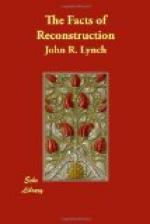Stockdale was a different type of a man from Van Eaton. He was in perfect accord with the dominant sentiment of his party. He felt that he had been nominated to go to Congress,—“peaceably and fairly,” if possible, but to go in any event. Then, again, that was the year of the Presidential election, and the Democrats were as confident of success that year as they had been in 1876 and in 1880.
For President and Vice-President the candidates were Blaine and Logan, Republicans, and Cleveland and Hendricks, Democrats.
Mr. Cleveland had the prestige of having been elected Governor of New York by a majority of about one hundred thousand. New York was believed to be the pivotal and the decisive State, and that its votes would determine the election for President. That the Republicans, even with such a popular man as Mr. Blaine as their candidate, would be able to overcome the immense majority by which Mr. Cleveland had carried the State for Governor was not believed by any Democrat to be possible. The Democrats did not take into account any of the local circumstances that contributed to such a remarkable result; but they were well known to Republicans in and out of that State. One of the principal contributory causes was a determination on the part of thousands of Republican voters in that State to resent at the polls National interference in local State affairs.
Judge Folger, President Arthur’s Secretary of the Treasury, was the Republican candidate against Mr. Cleveland for the Governorship when the latter was elected by such an immense majority. It was a well-known fact that Judge Folger could not have been nominated but for the active and aggressive efforts of the National Administration, and of its agents and representatives. The fight for the Republican nomination for Governor that year was the beginning of the bitter fight between the Blaine and the Arthur forces in the State for the delegation in 1884. In the nomination of Judge Folger the Blaine men were defeated. To neutralize the prestige which the Arthur men had thus secured, thousands of the Blaine men, and some who were not Blaine men, but who were against the National Administration for other reasons, refused to vote for Judge Folger, and thus allowed the State to go Democratic by default. In 1884, when Mr. Blaine was the candidate of the Republicans for the Presidency, a sufficient number of anti-Blaine men in New York,—in a spirit of retaliation, no doubt,—pursued the same course and thus allowed the State again to go Democratic by default. The loss which Mr. Blaine sustained in the latter case, therefore, was much greater than that gained by him in the former.




